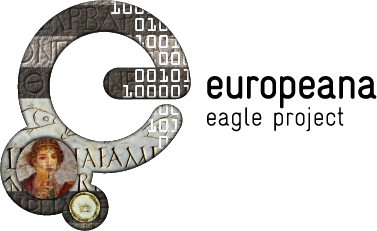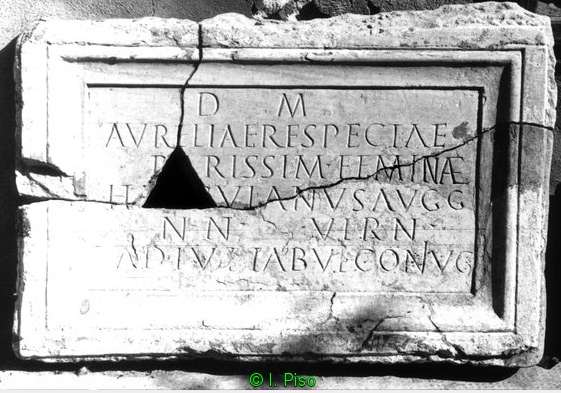This is the story of Herculanus, an important imperial slave attested at Sarmizegetusa (the capital of Roman Dacia, today a village bearing again its ancient name since 1941), on two different inscriptions that have never been linked to each other in the past.
Grabinschrift der Aurelia Respecta
- Trismegistos-Id: n/a_PLUS::1634908a456f1807f5c7375e92dddeb2
- Material: stone / marble
- Type: inschriftfeld
- inscriptionType: grabinschrift
- conservationPlace: Sarmizegetusa (Gradiste, Varhely), Rumänien
- findingSpotModern: Sarmizegetusa (Gradiste, Varhely), Rumänien
- entityType: visual
- Repository: Ubi erat lupa
- no response to http://pelagios.org/peripleo/places/http%3A%2F%2Fpleiades.stoa.org%2Fplaces%2F207527!
#0 /var/www/html/eagle/wp-content/plugins/eagle-storytelling/esa_datasource.class.php(222): esa_datasource\abstract_datasource->_fetch_external_data('http://pelagios...') #1 /var/www/html/eagle/wp-content/plugins/eagle-storytelling/esa_datasource.class.php(207): esa_datasource\abstract_datasource->_generic_api_call('http://pelagios...') #2 /var/www/html/eagle/wp-content/plugins/eagle-storytelling/esa_item.class.php(142): esa_datasource\abstract_datasource->get('places/http%3A%...') #3 /var/www/html/eagle/wp-content/plugins/eagle-storytelling/esa_item.class.php(63): esa_item->_generator() #4 /var/www/html/eagle/wp-content/plugins/eagle-storytelling/eagle-storytelling.php(703): esa_item->html(true) #5 /var/www/html/eagle/wp-includes/shortcodes.php(434): esa_shortcode(Array, '', 'esa') #6 [internal function]: do_shortcode_tag(Array) #7 /var/www/html/eagle/wp-includes/shortcodes.php(273): preg_replace_callback('/\\[(\\[?)(esa)(?...', 'do_shortcode_ta...', 'This is the ...') #8 /var/www/html/eagle/wp-includes/class-wp-hook.php(324): do_shortcode('
This is the ...') #9 /var/www/html/eagle/wp-includes/plugin.php(205): WP_Hook->apply_filters('
This is the ...', Array) #10 /var/www/html/eagle/wp-includes/post-template.php(256): apply_filters('the_content', 'This is the sto...') #11 /var/www/html/eagle/wp-content/plugins/eagle-storytelling-bridge/template/loop-single-story.php(38): the_content() #12 /var/www/html/eagle/wp-content/plugins/eagle-storytelling-bridge/template/single-story.php(9): include('/var/www/html/e...') #13 /var/www/html/eagle/wp-includes/template-loader.php(106): include('/var/www/html/e...') #14 /var/www/html/eagle/wp-blog-header.php(19): require_once('/var/www/html/e...') #15 /var/www/html/eagle/index.php(17): require('/var/www/html/e...') #16 {main}
The first inscription was found by a 19th century scholar on the propriety of baron Nopcsa, an antiquities collector whose estate was located about 20 km north from Sarmizegetusa. The inscription reads that Herculanus, a slave born in the emperor’s household and holding the office of assistant in the public archives (adiutor tabularii), buried his wife, Aurelia Respecta.
The second inscription was discovered by Romanian archaeologist Octavian Floca in 1953, in the Sarmizegetusa necropolis. Quite deteriorated, epigraphists didn’t link it to the first one, though a Herculanus appeared on it as well. After analyzing its content as well as its stylistic details, we state with certainty that it speaks about the same man. This time Herculanus, holding the same office, buries not only a second wife, Claudia Turpilla, but a son as well. The boy, Carus, was placed under the direct protection of the throne’s heir (designated as caesar during the period).
Grabinschrift der Claudia Turpilla
- Trismegistos-Id: n/a_PLUS::55d491cf951b1b920900684d71419282
- Material: stone / marble
- Artifact Type: inscription
- Type: inschriftfeld
- conservationPlace: Sarmizegetusa (Gradiste, Varhely), Rumänien
- findingSpotAncient: Samum , Dacia
- findingSpotModern: Sarmizegetusa (Gradiste, Varhely), Rumänien
- entityType: artifact
- Repository: Ubi erat lupa
Based on imperial titles – the double g from Auggustorum on the first epitaph means that 2 emperors were reigning at the time, while from the second inscription we know that the reigning emperor had an officially designated heir to the throne – but as well on the writing style of the epitaphs, we concluded that they date from the periods of 161-169 (when Marcus Aurelius & Lucius Verus reigned as co-emperors)/177-180 (when Marcus Aurelius & Commodus were associated augusti), respectively 139-161 (when Antoninus Pius was emperor and Marcus Aurelius – his heir) /166-177 (when Marcus Aurelius had his son Commodus designated as caesar). The monuments, plaques covering niches where the ash urns were deposited, come from a mausoleum (or columbarium) that the imperial slaves and freedmen had in the necropolis of Sarmizegetusa.
Herculanus was an exceptionally character in Sarmizegetusa: his office was usually held by imperial freedmen, so a slave holding it is sign of great favour; as well, his son being the “property” of the caesar is as well an indicator of strong bounds with the imperial house. His high position is proved by the fact that both his wives were citizens – for whom marring a slave was not a problem, as his de facto situation was much better than that of most of the city’s citizens.

